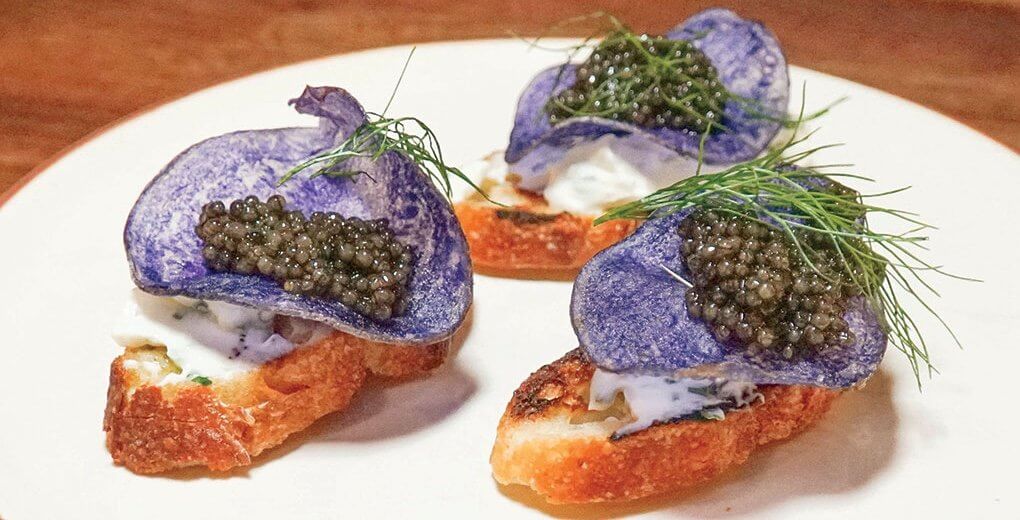
This is the second installment of our annual menu-trends research tour where on week-long ventures in New York, Chicago and Los Angeles we visit on average 40 newly opened restaurants in the space of five days. Of course, being able to complete visits to eight restaurants per day requires careful planning.
But as thorough as we are in covering the details, inevitable snags do occur. A great example is from Day 4 of our New York trip, when a freak cold front blew in and dumped a half foot of wet snow on the city in four hours, resulting in nearly complete traffic gridlock. Needless to say, we did not make our eight visits that day. In the end, though, we came back with rich insights and fresh ideas from each city, thanks to the chefs and operators whose new concepts are driving the next wave of innovation on American menus.
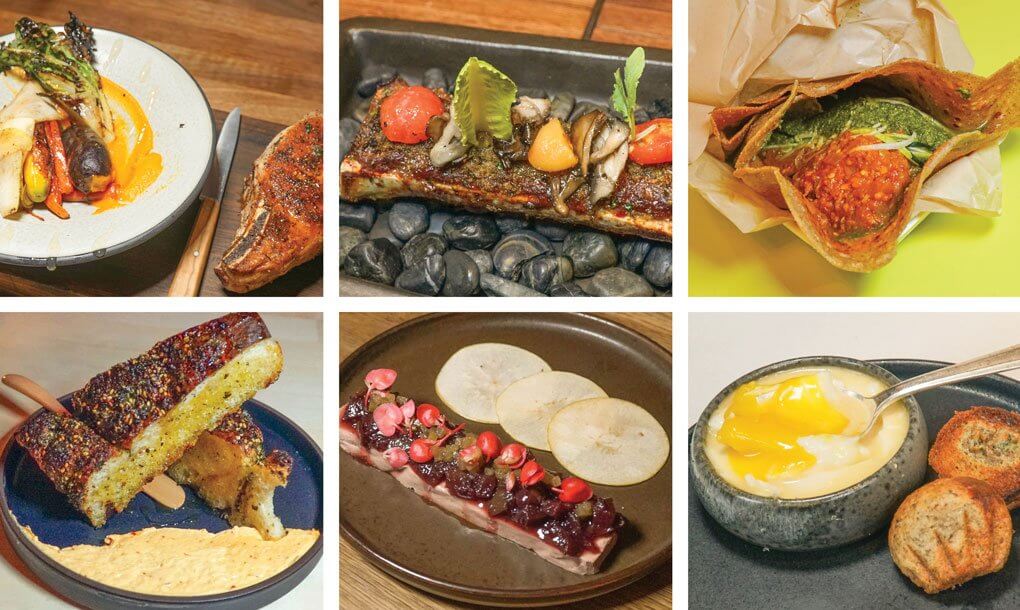 Gerry Ludwig
Gerry Ludwig Innovating anew with on-trend ingredients (clockwise from top left): Pork chop with charred carrots and boudin noir at Tesse; Oiji’s short rib dish stars bone marrow; Frankie Goes to Bollywood menus a Frankie with eggplant curry; soft-baked egg with mushroom-stuffed brioche at La Mercerie; chicken liver mousse with poached apples at Ferris; and Atrium’s Grilled Focaccia with kimchi butter and buckwheat honey.
The French Resurgence
In a classic example of the old becoming new again, the past year has seen a mini-explosion of French restaurant openings in the major cities, including Tesse in West Hollywood, Calif., and Le Sud, Bar Biscay and Taureaux Tavern in Chicago. In New York, new French eateries include La Mercerie, Chez Ma Tante in Brooklyn, Maman & Mimi, Bistro Pierre Lapin, and the wildly popular, award-winning Frenchette. It is not surprising that Flavor & The Menu cited the “French Evolution” as one of the Top 10 Trends for 2019.
And as is expected from new restaurants that feature a specific global cuisine, experimentation with classic treatments was consistently evident, with the chefs creating fresh interpretations of old favorites.
Incredible Eggs
Egg in all its glory (clockwise from top left): Osetra caviar atop eggs at Taureaux Tavern; Frenchette’s soft scrambled eggs with escargot; smoked trout caviar at Le Sud; sieved yolk adds texture to Oeuf Mayonnaise at La Mercerie.
Eggs are a particular area of passion in French cuisine, and many of these new menus featured multiple egg-based preparations. The venerable dish Oeuf Mayonnaise was a frequent offering, yet each version was uniquely prepared and presented. At Taureaux Tavern, Mike Sheerin, executive chef, sets a halved eight-minute egg in a pool of garlic mayonnaise and finishes the dish with a drizzle of maple syrup and generous dollops of osetra caviar, while at La Mercerie, chef Marie-Aude Rose fills hollow egg whites with an ultra-thick housemade mayonnaise and finishes the dish with a blizzard of sieved yolk. She also serves an exceptional Oeuf Cocotte, eggs that are soft-baked in white-wine cream sauce with a mushroom duxelles-stuffed brioche bun served on the side. Most astounding was the Brouillade at Frenchette, a plate of perfectly silken soft scrambled eggs, simply topped with a few escargot sautéed in green garlic butter.
The other “egg” dominating these new French menus is caviar, served both as a freestanding course with classic accompaniments, and as a luxurious garnish. The Caviar Toast at Tesse is a one-bite treat of toasted crouton layered with crème fraîche and a crisp purple potato chip topped with caviar de Sologne. The Blinis Demidoff at La Mercerie are equally diminutive and delicious: coin-sized buckwheat pancakes topped with a smear of artisanal lemon butter and osetra caviar. And while these examples feature costly imported caviars, we were enthused to see many chefs serving premium American caviars, which have been rapidly rising in popularity because of their quality and markedly lower cost compared to the imports. Of particular note was the caviar service at Le Sud, a generous two ounces of wild-caught Washington state steelhead trout roe surrounded by sieved egg, crème fraîche, pickled shallots and shaved bread crisps. These domestic caviars are enabling a growing number of chefs to create visually arresting plate presentations featuring a unique combination of craveability and affordable elegance.
 Gerry Ludwig
Gerry Ludwig Egg in all its glory (clockwise from top left): Osetra caviar atop eggs at Taureaux Tavern; Frenchette’s soft scrambled eggs with escargot; smoked trout caviar at Le Sud; sieved yolk adds texture to Oeuf Mayonnaise at La Mercerie.
Menu Standout: Ants on a Log
The childhood treat of celery sticks slathered with peanut butter and topped with raisins is now being morphed into an adult bar snack. We encountered two versions, both in Chicago, and both uniquely delicious. Z Bar abandons the original combination of peanut butter and raisins in favor of crème fraîche that is artfully piped onto the celery sticks and topped with tiny mounds of California white sturgeon caviar. At the Midwestern-themed Twain, chef Tim Graham retains the peanut butter, but blends it with a creamy duck liver mousse and finishes the filled celery stick with bourbon-macerated cherries.
While these may seem like niche concepts, they are simple to prepare and boldly flavored, and could easily become signature items for both cocktail and sports bars, and any casual venue looking for a new snack or sharing plate.
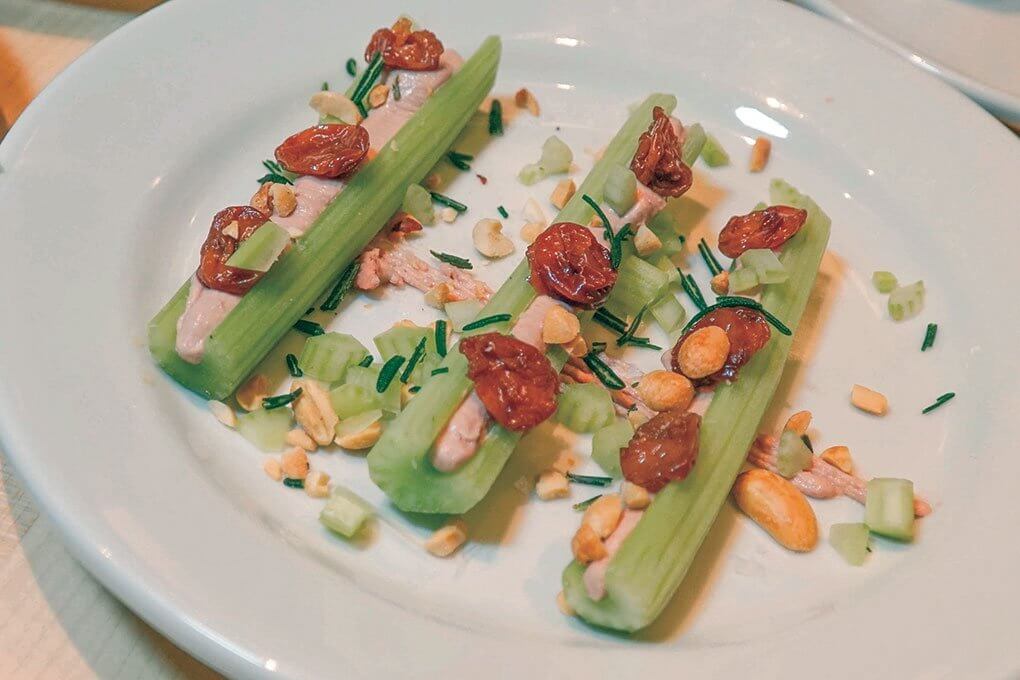 Gerry Ludwig
Gerry Ludwig At Z Bar, “ants” are California white sturgeon caviar over crème fraîche.
50 Ways To Love Your Liver
We believe that French cuisine’s return to popularity will result in the increased appearance of Gallic-inspired dishes on mainstream menus. This is already occurring with chicken liver pâté, a dish possessing strong appeal for both dining consumers seeking a rich and indulgent treat, and chefs who appreciate the low cost of the base ingredient. We found chicken liver spreads and mousses not only in French restaurants during our research, but on a wide range of menus, from sharing-plate restaurants to cocktail bars.
On the French side, Tesse served its Chicken Liver Parfait in a small jar topped with frisée and accompanied by toasted brioche and apricot jam, while Chez Ma Tante generously smeared its Chicken Liver Pâté on one side of a plate and finished the dish with a small mound of piparras (pickled peppers).
Our favorite treatment in a mainstream restaurant was the Chicken Liver Mousse from Greg Proechel, executive chef at Ferris in New York—an oblong bar of pâté garnished with apples poached in sour beer and sprinkled with apple blossoms. A close second was the Chicken Liver Pâté from New York restaurateur Gabriel Stulman’s Simon & The Whale, topped with housemade blackberry jam and toasted oats. The plate of Chicken Liver Mousse at nearby cocktail bar Existing Conditions exemplified simplicity, accompanied only by a ramekin of grain mustard and a mini-sleeve of Ritz crackers.
From creative updates of Southern French comfort dishes such as cassoulet, bouillabaise and daube, to craveable gratins, blanquettes and confits, this resurgence solidly positions French cuisine to provide innovation for mainstream full-service restaurant menus and satisfy dining consumers seeking a break from the everyday.
 Gerry Ludwig
Gerry Ludwig (From left) Tied House offers a bread course with bone marrow butter, miso butter, green tomato marmalade and more; Twain serves a playful bone-marrow sloppy Joe; Marrow Poppers at Z Bar star potato, marrow and Calabrian chile; Frenchette’s Celtuce Gratin sees bone marrow, soft herbs and breadcrumbs; and Tesse combines bone marrow, bucatini, duck prosciutto and Parmesan.
Bread & Butter Reimagined
Elevated bread service (clockwise from top left): La Mercerie serves wheat boule slices with olive oil-lemon butter while Twain offers a category of bread plates including: Corn Sticks with green pepper jelly and honey butter; Pretzel Biscuit with malt butter; and Egg Harbor Bread with whipped bacon-fat butter.
While conventional bread-and-butter service at restaurants is largely a thing of the past, an unexpected and inspiring discovery from our latest research was the significant number of new concepts with a signature bread-and-butter plate offered on the menu.
Many of the new French venues we visited placed their focus on the butter, offering small-batch, house-churned, cave-aged and imported artisanal varieties, while mainstream casual and casual-upscale spots highlighted housemade breads, rolls and biscuits as the centerpiece of the dish, accompanied by flavorful compound butters.
La Mercerie offers a plate of toasted wheat boule slices with a choice of two hand-kneaded butters imported from Brittany, one made with buckwheat and the other flavored with olive oil and lemon, selling for a neat $7. Chicago’s Twain is an ode to Midwestern cuisine, thanks to Tim Graham, executive chef. The menu features a category of bread plates selling for $3 to $4, including an Egg Harbor Bread with bacon-fat butter, Corn Bread Sticks with green-pepper jelly and honey butter, and Cheddar Chive Drop Biscuits with malt butter. At Atrium in Los Angeles, Hunter Pritchett, chef/owner, sells a $7 plate of olive-oil-drenched Grilled Focaccia, accompanied by kimchi butter and buckwheat honey.
Most notable was the Tied House Bread Course, served at the Chicago restaurant of the same name. A large, celebratory sharing platter intended for tables of four or more, the $32 Bread Course is a compilation of assorted breads and housemade compound butters and condiments, including bone-marrow butter, miso butter, crème fraîche with honeycomb, green-tomato marmalade, and chicken liver mousse. The surprising twist is that all of the breads are purchased from a local artisan baker rather than made in-house, which the waitstaff states up front when describing the dish.
It is always gratifying to see operators selling quality and charging for it. The bread-and-butter plate continues to evolve away from a complimentary prelude to the meal—often served as an afterthought and intended as a “filler” for hungry diners—into a sales-building sharing plate that is thoughtfully crafted and carries a commensurate selling price.
 Gerry Ludwig
Gerry Ludwig Elevated bread service (clockwise from top left): La Mercerie serves wheat boule slices with olive oil-lemon butter while Twain offers a category of bread plates including: Corn Sticks with green pepper jelly and honey butter; Pretzel Biscuit with malt butter; and Egg Harbor Bread with whipped bacon-fat butter.
Menu Standout: The Frankie
The Frankie is often referred to as “the Indian Burrito.” It is classically composed of Indian spiced meats, vegetables and sauces wrapped in an oversized, thinly rolled naan bread. We first reported on the Frankie two years ago, when authentic versions were first served up at fast-casual concept The Bombay Frankie Company in Los Angeles, and New York’s Pondicheri chef/owner Anita Jaisinghani introduced mashed-up breakfast and brunch versions.
This year we were treated to an eclectic array of authentic and mashed-up Frankies served on a unique gluten-free flatbread at the new quick-serve concept Frankie Goes To Bollywood in New York.
The flatbreads used at each of these venues are slightly different in size, texture and flavor, validating our assertion that the Frankie is more about the fillings, allowing significant leeway in the choice of carrier as long as it is tasty and large enough to hold its contents. So, in our view, any operator that is already using a burrito tortilla or large sandwich wrap could easily expand the flavor and variety on their menus by offering some form of Indian-inspired “burrito.”
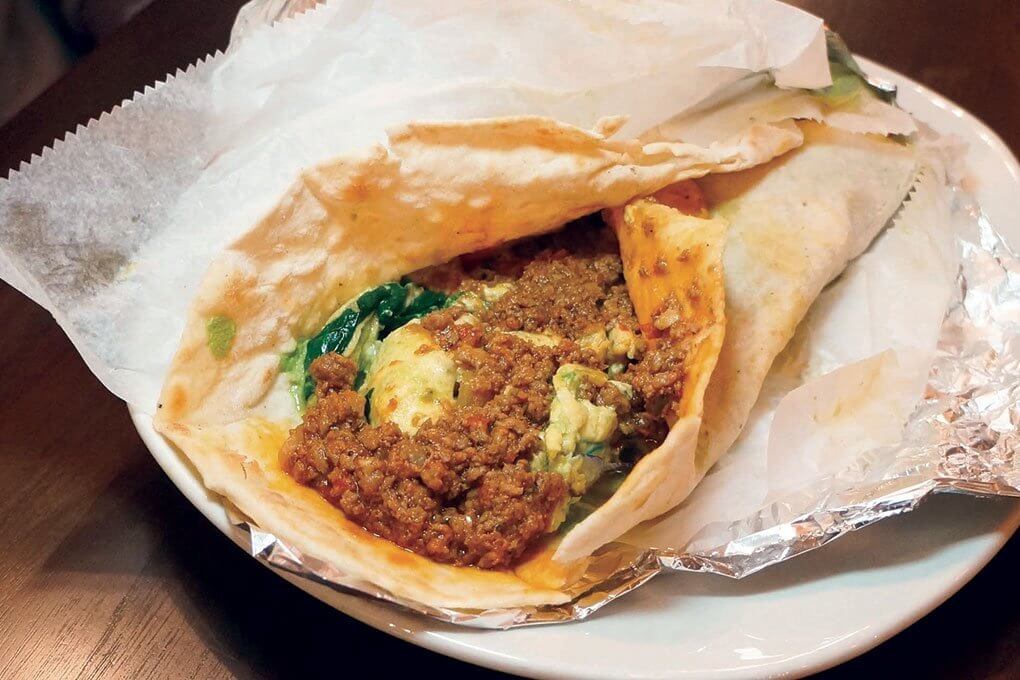 Gerry Ludwig
Gerry Ludwig Pondicheri menus a Breakfast Frankie that sees a roti wrap stuffed with masala egg and chutney.
Marrow: No Bare Bones
Once a menu darling of the gastropub segment, roasted bone marrow dishes experienced a decline in mainstream popularity over the last half decade. Today, this member of the offal category is earning renewed space on menus, but the treatments are no longer just about “bone and bread.” The latest versions layer in flavors via the creative addition of toppings, crustings and sauces.
A delicious and slightly whimsical example is the Sloppy Marrow served at Twain, where a large split marrow bone is roasted, placed on a slice of white bread, smothered in beef sloppy Joe, and finished with a drizzle of yellow mustard and diced white onion. Decidedly more upscale and complex is the Bone Marrow from Korean restaurant Oiji in New York’s East Village. Brian Kim and Tae Kyung Ku, co-chefs/co-owners, top the raw, split bone with spoon-tender short rib braised with makkoli rice wine and gochugaru, and then oven-roast the bone until the short rib has formed a crunchy crust. The dish is finished with roasted tomatoes and maitake mushrooms, and dramatically presented on a bed of hot stones. Chef Sheerin takes a slightly different approach at Taureaux Tavern with his Oxtail & Bone Marrow dish, roasting the bone on a bed of pulled oxtail in a cast-iron pan, and topping it with an assortment of torn fresh herbs tossed with pickled shallots.
Other innovative treatments include the Marrow Poppers at Chicago’s Z Bar, where small lobes of marrow are coated with bordelaise sauce, wrapped in shredded potato, deep fried and served with a Calabrian chile aïoli. The Bucatini and Bone Marrow at Tesse pairs a dish of buttery herbed pasta with a roasted marrow bone that has its contents scraped into the pasta and tossed tableside. A craveable veg-centric Celtuce Gratin at Frenchette features thick lettuce stems baked in a bone marrow-laced sauce topped with toasted breadcrumbs.
All of these examples are highly indulgent for sure, but for diners making that less-frequent visit to a full-service restaurant and seeking a treat, bone marrow dishes fully fit the bill.
 Gerry Ludwig
Gerry Ludwig (From left) Tied House offers a bread course with bone marrow butter, miso butter, green tomato marmalade and more; Twain serves a playful bone-marrow sloppy Joe; Marrow Poppers at Z Bar star potato, marrow and Calabrian chile; Frenchette’s Celtuce Gratin sees bone marrow, soft herbs and breadcrumbs; and Tesse combines bone marrow, bucatini, duck prosciutto and Parmesan.
Unique Taco Treatments
There is always room in the American foodscape for one more innovative taco idea. We found several at mainstream casual full-service restaurants, including the chipotle-spiked, bacon-wrapped pineapple Pastor Tacos at Merchant in Chicago. But the best came from dedicated taco restaurants, such as fast-casual Guerilla Tacos in Los Angeles, whose extensive menu of non-traditional taco fillings such as sweet potato with almond; feta cheese and fried corn, butternut squash with halloumi cheese; dates and candied pecans; and salsa rojo beef with rajas, Oaxacan cheese and foie gras wowed our entire team (R.I.P. foie gras, which has since been banned in California).
A stunningly delicious treatment that we believe has huge growth potential is the “red taco,” served by Teddy Vazquez, a former Uber driver turned taco tycoon, at both his Teddy’s Red Tacos food truck in Los Angeles and a new brick-and-mortar shop in Venice, Calif. Vazquez offers only one type of taco filling: a birria-style shredded beef that is simmered in a broth spiked with ample amounts of red chiles, and served only on corn tortillas. Each tortilla is dipped in the crimson birria broth before being griddled or fried, lending a deep orange hue and a rich, complex layer of chile flavor that, when filled with the shredded beef and garnished, results in a singular taco whose craveability can only be grasped through tasting.
While the red taco is a lightning-in-a-bottle type of dish that should rightfully be owned by Teddy Vazquez (time will tell), tacos enjoy such immense popularity with dining consumers in all age groups that opportunities abound to expand menu differentiation with creatively executed new variations.
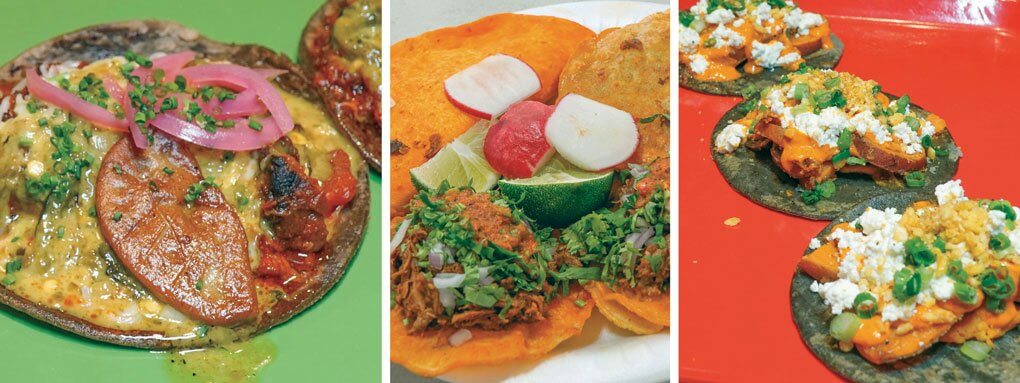 Gerry Ludwig
Gerry Ludwig (Left to right) Guerilla Tacos’ Salsa Roja Beef Taco combines three different chiles with Oaxacan cheese, pickled onions and foie gras; the Deluxe Plate at Teddy’s Red Tacos stars birria-style. shredded beef simmered in red-chile broth served in a variety of formats; Sweet Potato Tacos exemplify the unique treatments at Guerilla Tacos. Almond chile, feta and fried corn add interest.
Menu Standout: Blood Sausage
While the mere name of this ingredient may cause some dining consumers to run screaming, blood sausage is in fact gaining traction on several new restaurant menus.
At Ferris, chef Greg Proechel serves a sharing plate of Blood Sausage that is griddled into crispy crumbles and tossed with grilled dates, shaved carrots, puffed rice and toasted sunflower seeds. The Berkshire Pork Chop at Tesse is accompanied by a link of the French blood sausage Boudin Noir. And Chez Ma Tante serves a generous slab of griddled Blood Cake that is topped with a sunny-side fried egg.
Also helping to expose American diners to this flavorful ingredient are the increasing number of Korean restaurants in Los Angeles that specialize in dishes based on the indigenous blood sausage known as soondae.
The unfortunate fact is that the greatest barrier to wider acceptance of blood sausage is the name. It has a pleasantly spicy flavor, with a texture that varies from creamy to crunchy, depending on the preparation. As dining consumers become increasingly sophisticated and chefs continue to experiment with an expanding array of global ingredients, we may see this much-maligned sausage moving closer to the mainstream.
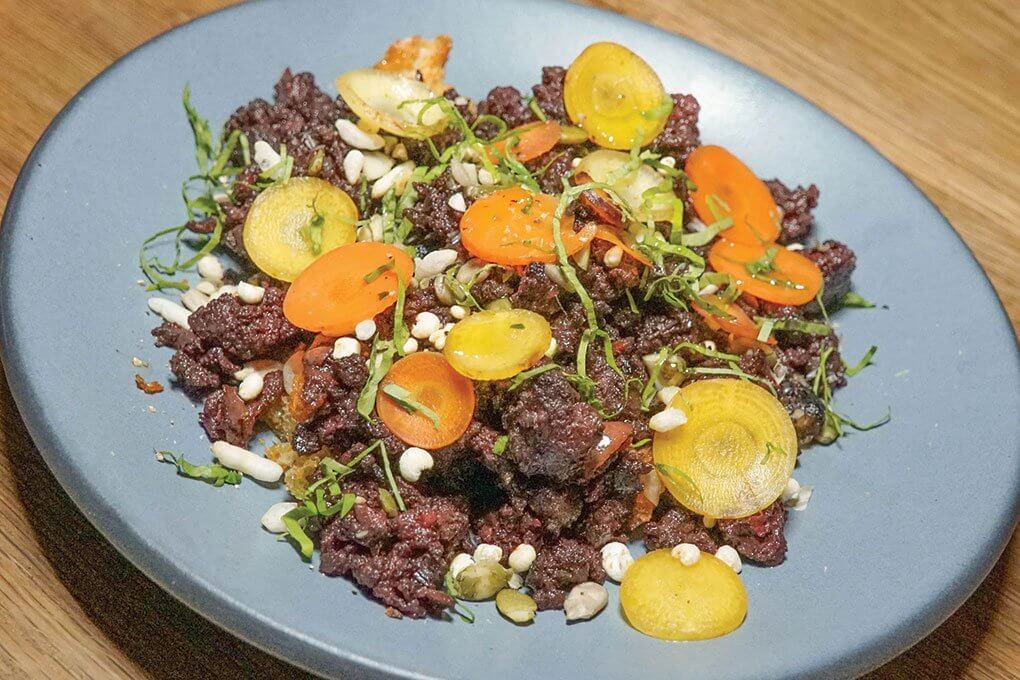 Gerry Ludwig
Gerry Ludwig The Blood Sausage at Ferris features grilled dates, puffed rice, beef-fat croutons and sunflower seeds.
Part One of this report appeared in the March/April 2019 issue of Flavor & The Menu.
The third and final installment will appear in the September/October 2019 edition.

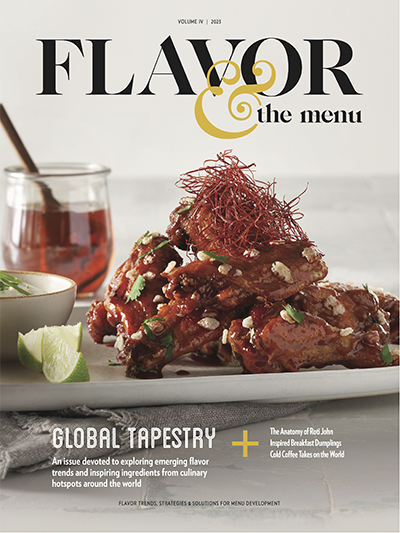


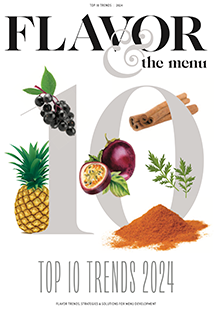
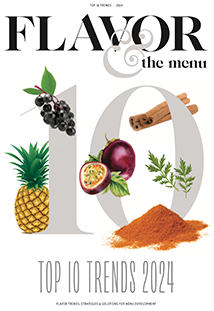

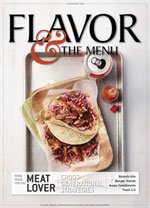 From the July-August 2019 issue of Flavor & The Menu magazine
From the July-August 2019 issue of Flavor & The Menu magazine